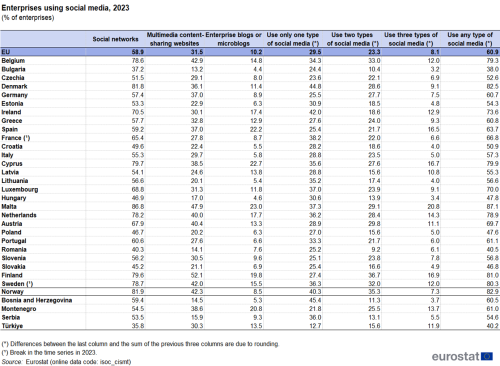Data extracted in June 2024
Planned article update: June 2026
Highlights
Social networks (58.9 %) were the most used form of social media in 2023; compared to 2015 their use increased by 24.8 percentage points.
Enterprises using social media, 2015 and 2023
Businesses raise their internet profile by using social media
This article presents recent statistics on the use of social media by enterprises in the European Union (EU).
Social media are part of the digital technologies that enterprises exploit to increase their presence on the internet, improve marketing opportunities, communicate and interact with partners, customers and other organisations, and facilitate collaboration and knowledge-sharing within the enterprise.
Social media refer to internet based applications such as social networks, blogs, multimedia content-sharing sites and wikis. In principle, enterprises use social media for image building or for marketing purposes, for gaining insights from customers or communicating within or outside the enterprise or for recruiting.
Social media, a business paradigm shift
For more than a decade, there has been a shift from the static webpages of the earlier websites towards web applications which draw on user data and relevant applications stored in the cloud. In that time, a multitude of internet-based services, collaborative web applications and interactive websites have appeared. Users have been encouraged to subscribe to these services, to author, post and share user-generated content and to add links to other websites. In addition, individuals and enterprises have been able to exchange information, experiences and opinions in the form of ‘many-to-many dialogues’ over internet communication platforms. These virtual interaction platforms have, in fact, been part of a paradigm shift in the way enterprises communicate with their customers.
Enterprises have not only progressively embraced this new generation of highly dynamic web applications, but have also adopted new behaviours. They have integrated social media into the way they run their business, organised forms of internal communication apart from the management chain and, most importantly, communicated and interacted with customers using the new applications. From that point of view it has been possible for customers to influence business decisions and assist companies in designing and marketing their products.
Use of social media by enterprises
Enterprises seek to enhance their internet presence by exploiting the possibilities that social media offer. The three widely known categories of social media are:
- Social networks such as Facebook, LinkedIn, Xing, and others;
- Corporate blogs or microblogs such as X and others;
- Multimedia content-sharing websites such as YouTube, Instagram, Flickr, SlideShare, and others.
In 2023, 60.9 % of EU enterprises used at least one of these types of social media, an increase by 24.1 percentage points compared to 2015. Percentages do vary widely from country to country, ranging from 80 % and more in Malta (87.1 %), Denmark (82.5 %), Finland (81 %) and Sweden (80.3 %) to less than 45 % in Romania (40.5 %) and Bulgaria (38 %) (Figure 1).

(% of enterprises)
Source: Eurostat (isoc_cismt)
As shown in Figure 2, 60.9 % of EU enterprises used social media in 2023. More than 8 in 10 large enterprises (86 %) reported using social media, a share significantly higher than the one recorded for small enterprises (58 %). It is noticeable that 29.5 % of enterprises in the EU used only one of the three types of social media and another 23.3 % used two types of social media. 8.1 % of enterprises reported using 3 types of social media.
Almost one third of small enterprises (29.5 %) preferred to concentrate on the use of one type of social media compared to slightly less than one-fourth (23.3 %) using two and 6.4 % using three types of social media. On the contrary, the shares of EU large enterprises using two and three types of social media (31.7 % and respectively 29.8 %) were higher than the percentage using only one type (24.5 %) (Figure 2).
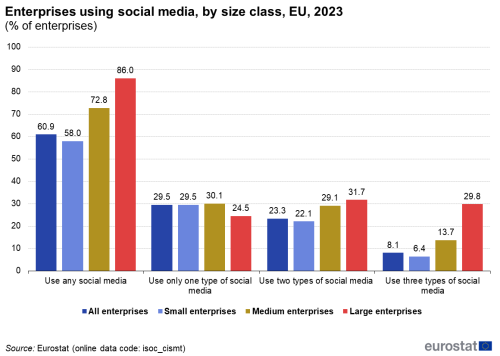
(% of enterprises)
Source: Eurostat (isoc_cismt)
Social networks were more popular than other types of social media. Some 58.9 % of enterprises in the EU used social networks empowering customers to connect by creating personal information profiles, to share experiences, to express opinions, to exchange information and, most importantly, to create communities of people with common interests around the enterprises’ product brands. The percentage of EU enterprises using social networks ranged from 86.8 % in Malta to 37.2 % in Bulgaria (Table 1).
The use of blogs or microblogs and content-sharing websites was less popular among EU enterprises, at 10.2 % and 31.5 % respectively. Corporate blogs are websites that are updated frequently, up to several times a day, with posts that contain text, images, audio or videos. Blogs can be used either inside an enterprise or for communicating with outside parties such as customers, business partners or other organisations. Microblogging is posting very short text messages, usually of a few hundred characters or less, and sharing hyperlinks to other websites, which usually contain longer text, videos or images. Multimedia content communities give enterprises the opportunity to share media content with potential or current customers, thus enhancing their marketing capacity. They may release photos and videos or share presentations and documents over the internet that may be linked to blogs and other social networking services or websites. The percentages of EU businesses using blogs or microblogs were highest in Malta (23 %), Cyprus (22.7 %) and Spain (22.2 %); multimedia content-sharing websites were highest in Finland (52.1 %), Malta (47.9 %) and in Belgium (42.9 %) (Table 1).
Types of social media used over time (2015 - 2023)
Between 2015 and 2023, the share of EU enterprises using social networks increased from 34.1 % to 58.9 % (Figure 3). During the same period the use of multimedia content-sharing websites increased by 19.2 percentage points (from 12.3 % to 31.5 %) and of blogs or microblogs by 0.9 percentage points (from 9.3 % to 10.2 %).
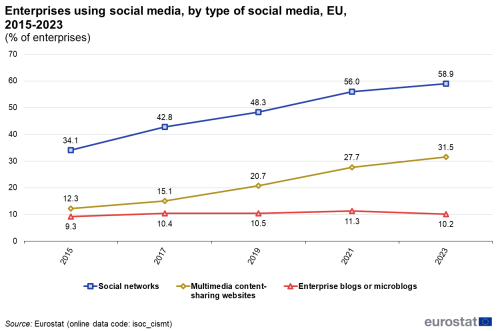
(% of enterprises)
Source: Eurostat (isoc_cismt)
In the EU, between 2015 and 2023 the use of social networks increased most (by 24.8 percentage points) compared to the other social media types. Among the Member States the highest increases were reported in Belgium (by 36.3 percentage points), Finland (by 32.3 percentage points) and Luxembourg (by 31.9 percentage points) (France recorded an increase by 37 percentage points, however there was a break in the time series in 2023). The lowest increases were recorded in Bulgaria (by 7.7 percentage points) and Ireland (by 8.9 percentage point), although it needs to be noted that in 2015 the uptake of social networks in Ireland was already at relatively high level compared to other countries (second highest in the EU) (Figure 4).
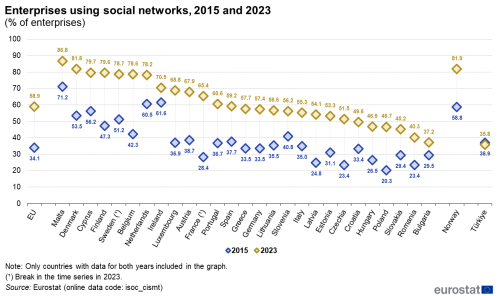
(% of enterprises)
Source: Eurostat (isoc_cismt)
Types of social media used by enterprise size class
In 2023, 84.8 % of EU large enterprises used some kind of social networks. By contrast, slightly more than half of small enterprises (55.9 %) used social networks. Multimedia content-sharing websites were used by almost three fifth of the large enterprises (59.1 %) compared to more than one quarter of the small EU businesses (28.7 %). In 2023, the share of large enterprises using enterprise blogs or microblogs (33.4 %) was almost four time higher than the percentage recorded for small enterprises (8.4 %) (Figure 5).
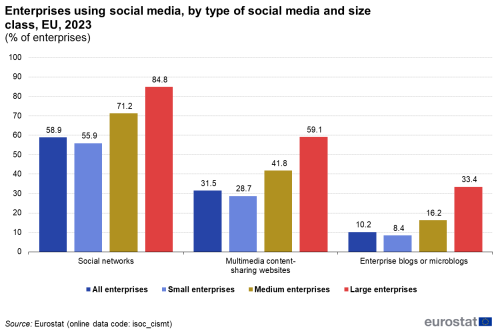
(% of enterprises)
Source: Eurostat (isoc_cismt)
Types of social media used by economic activity
Considering the economic activity, during 2023 the percentage of EU enterprises using social networks ranged from 83.2 % of enterprises in the accommodation sector and 81.5 % in the information and communication sector to 41.3 % of enterprises in transport and storage and in construction (44.1 %). Multimedia content-sharing websites were used by more than 5 out of 10 businesses in the accommodation sector and in the information and communication sector, but by less than 1 out of 5 enterprises in transport and storage sector and construction sector. Enterprise blogs or microblogs were popular types of social media among enterprises in the information and communication sector (36.7 %). On the contrary, less than 5 % of the EU businesses in construction used enterprise blog or microblogs (Figure 6).

(% of enterprises)
Source: Eurostat (isoc_cismtn2)
Source data for tables and graphs
Data sources
Data presented in this article are based on the results of the 2023 survey on ICT usage and e-commerce in enterprises. Statistics were obtained from surveys conducted by the national statistical authorities in early 2023.
In 2023, 150 400 of the 1.47 million enterprises in the EU were surveyed. Of these enterprises, approximately 83 % were small enterprises (10-49 employees and self-employed persons), 14 % medium enterprises (50-249 employees and self-employed persons) and 3 % large enterprises (250 or more employees and self-employed persons).
Source data shown as ':' refer to data that are unavailable, unreliable, confidential or not applicable. Unreliable data are included in the calculation of European aggregates. Data presented in this article may differ from the data in the database because of updates made after the data were extracted for this article. Data in the database are organised according to the survey year. The observation statistical unit is the enterprise, as defined under Regulation (EC) No 696/1993 of 15 March 1993. The survey covered enterprises with at least 10 employees and self-employed persons. Economic activities correspond to the NACE Revision 2 classification. The sectors covered are:
- manufacturing;
- electricity, gas and steam, air conditioning and water supply;
- construction;
- wholesale and retail trades, repair of motor vehicles and motorcycles;
- transportation and storage;
- accommodation and food service activities;
- information and communication; real estate;
- professional, scientific and technical activities;
- administrative and support activities;
- repair of computers and communication equipment.
Context
In 2019, the Commission President, Ursula von der Leyen, described how she wanted the EU to grasp the opportunities presented by the digital age. A Europe fit for the digital age is one of 6 Commission priorities for 2019-2024. This digital transformation is based on the idea that digital technologies and solutions should:
- open up new opportunities for businesses;
- boost the development of trustworthy technology;
- foster an open and democratic society;
- enable a vibrant and sustainable economy;
- and help fight climate change.
In 2021, the Digital Compass for the EU's Digital Decade, COM(2021)118 final, set the EU’s digital targets for 2030 around 4 cardinal points: skills, digital transformation of businesses, secure and sustainable digital infrastructures, and digitalisation of public services.
Explore further
Other articles
- Digital economy and society statistics - enterprises
- Use of artificial intelligence in enterprises
- Cloud computing - statistics on the use by enterprises
- E-business integration
- E-commerce statistics
- ICT security in enterprises
- Use of Internet of Things in enterprises
- ICT specialists - statistics on hard-to-fill vacancies in enterprises
- Impact of COVID-19 on the use of ICT in enterprises
- Impact of COVID-19 on e-sales of enterprises
Database
- Digital economy and society<noprint>, see:
- ICT usage in enterprises (isoc_e)
- Websites and use of social media (isoc_cism)
- Social media use by type, internet advertising and size class of enterprise (isoc_cismt)
- Social media use by type, internet advertising and NACE Rev.2 activity (isoc_cismtn2)
- Websites and use of social media (isoc_cism)
Thematic section
Selected datasets
Methodology
External links
Legislation
- Regulation (EC) No 808/2004 of the European Parliament and of the Council of 21 April 2004 concerning Community statistics on the information society
- Regulation (EC) No 960/2008 of 30 September 2008 implementing Regulation (EC) No 808/2004 concerning Community statistics on the information society
- Regulation (EC) No 1023/2009 of 29 October 2009 implementing Regulation (EC) No 808/2004 concerning Community statistics on the information society
- Regulation (EU) No 821/2010 of 17 September 2010 implementing Regulation (EC) No 808/2004 concerning Community statistics on the information society
- Regulation (EU) No 937/2011 of 21 September 2011 implementing Regulation (EC) No 808/2004 concerning Community statistics on the information society
- Regulation (EU) No 1083/2012 of 19 November 2012 implementing Regulation (EC) No 808/2004 concerning Community statistics on the information society
- Regulation (EU) No 859/2013 of 5 September 2013 implementing Regulation (EC) No 808/2004 concerning Community statistics on the information society
- Regulation (EU) No 1196/2014 of 30 October 2014 implementing Regulation (EC) No 808/2004 concerning Community statistics on the information society
- Regulation (EU) 2015/2003 of 10 November 2015 implementing Regulation (EC) No 808/2004 concerning Community statistics on the information society
- Regulation (EU) 2016/2015 of 17 November 2016 implementing Regulation (EC) No 808/2004 concerning Community statistics on the information society
- Regulation (EU) 2017/1515 of 31 August 2017 implementing Regulation (EC) No 808/2004 concerning Community statistics on the information society
- Regulation (EU) 2018/1798 of 21 November 2018 implementing Regulation (EC) No 808/2004 of the European Parliament and of the Council concerning Community statistics on the information society for the reference year 2019
- Regulation (EU) 2019/1910 of 7 November 2019 implementing Regulation (EC) No 808/2004 of the European Parliament and of the Council concerning Community statistics on the information society for reference year 2020
- Regulation (EU) 2020/1030 of 15 July 2020 laying down the technical specifications of data requirements for the topic 'ICT usage and e-commerce' for the reference year 2021, pursuant to Regulation (EU) 2019/2152 of the European Parliament and of the Council
- Regulation (EU) 2021/1190 of 15 July 2021 laying down the technical specifications of data requirements for the topic 'ICT usage and e-commerce' for the reference year 2022 pursuant to Regulation (EU) 2019/2152 of the European Parliament and of the Council
- Regulation (EU) 2022/1344 of 1 August 2022 laying down the technical specifications of data requirements for the topic 'ICT usage and e-commerce' for the reference year 2023, pursuant to Regulation (EU) 2019/2152 of the European Parliament and of the Council
- Regulation (EC) No 696/1993 of 15 March 1993 on the statistical units for the observation and analysis of the production system in the Community

